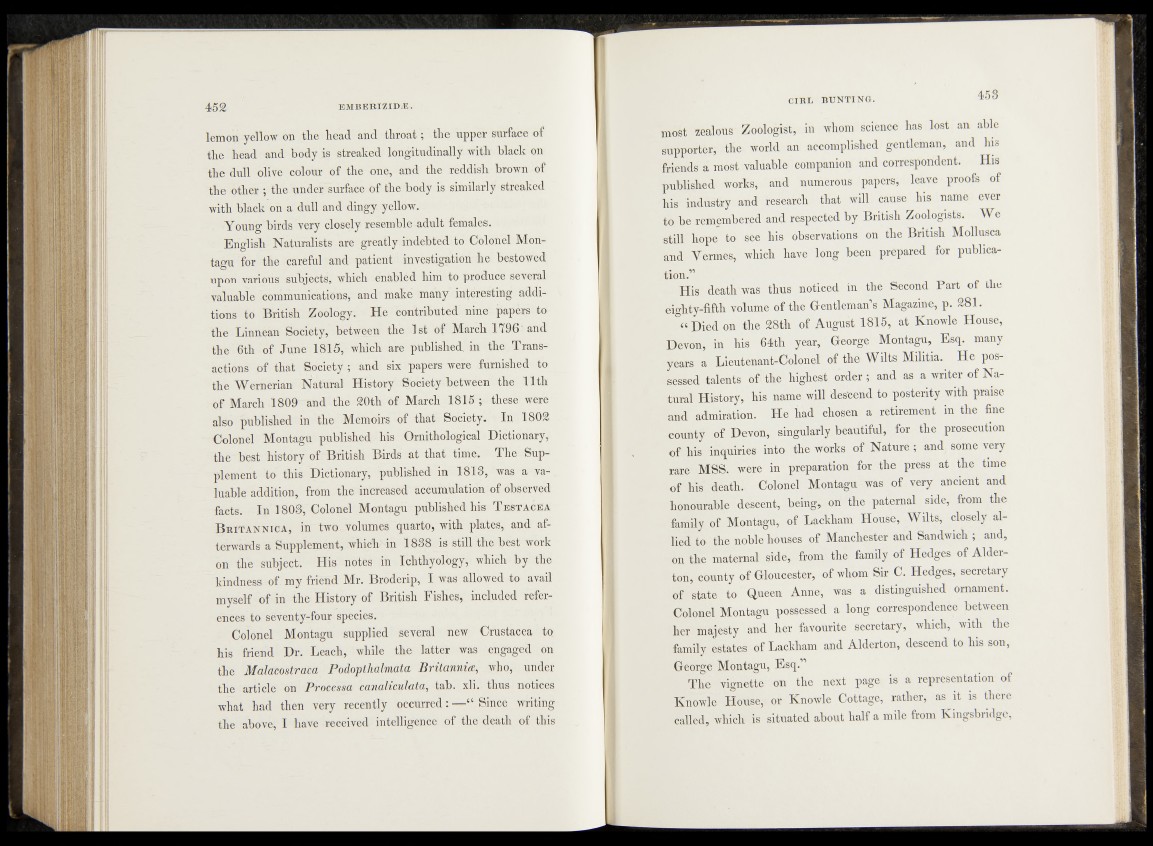
lemon yellow on the head and throat; the upper surface of
the head and body is streaked longitudinally with black on
the dull olive colour of the one, and the reddish brown of
the other ; the under surface of the body is similarly streaked
with black on a dull and dingy yellow.
Young birds very closely resemble adult females.
English Naturalists are greatly indebted to Colonel Mon-
tagu for the careful and patient investigation he bestowed
upon various subjects, which enabled him to produce several
valuable communications, and make many interesting additions
to British Zoology. He contributed nine papeis to
the Linnean Society, between the 1st of March 1796 and
the 6th of June 1815, which are published in the Transactions
of that Society ; and six papers were furnished to
the Wernerian Natural History Society between the 11th
of March 1809 and the 20th of March 1815 ; these were
also published in the Memoirs of that Society. In 1802
Colonel Montagu published his Ornithological Dictionary,
the best history of British Birds at that time. The Supplement
to this Dictionary, published in 1818, was a valuable
addition, from the increased accumulation of observed
facts. In 1808, Colonel Montagu published his T estacea
B ritannica, in two volumes quarto, with plates, and afterwards
a Supplement, which in 1888 is still the best work
on the subject. His notes in Ichthyology, which by the
kindness of my friend Mr. Broderip, I was allowed to avail
myself of in the History of British Fishes, included references
to seventy-four species.
Colonel Montagu supplied several new Crustacea to.
his friend Dr. Leach, while the latter was engaged on
the Malacostraca Podopthalmata Britannia, who, under
the article on Processa canaliculata, tab. xli. thus notices
what had then very recently occurred: —“ Since writing
the above, I have received intelligence of the death of this
most zealous Zoologist, in whom science has lost an able
supporter, the world an accomplished gentleman, and his
friends a most valuable companion and correspondent. His
published works, and numerous papers, leave proofs of
his industry and research that will cause his name ever
to be remembered and respected by British Zoologists. We
still hope to see his observations on the British Mollusca
and Vermes, which have long been prepared for publication.
1'’
His death was thus noticed in the Second Part of the
eighty-fifth volume of the Gentleman’s Magazine, p. 281.
“ Died on the 28th of August 1815, at Knowle House,
Devon, in his 64th year, George Montagu, Esq. many
years a Lieutenant-Colonel of the Wilts Militia. He possessed
talents of the highest order; and as a writer of Natural
History, his name will descend to posterity with praise
and admiration. He had chosen a retirement in the fine
county of Devon, singularly beautiful, for the prosecution
of his inquiries into the works of Nature ; and some very
rare MSS. were in preparation for the press at the time
of his death. Colonel Montagu was of very ancient and
honourable descent, being, on the paternal side, from the
family of Montagu, of Lackham House, Wilts, closely allied
to the noble houses of Manchester and Sandwich ; and,
on the maternal side, from the family of Hedges of Alder-
ton, county of Gloucester, of whom Sir C. Hedges, secretary
of state to Queen Anne, was a distinguished ornament.
Colonel Montagu possessed a long correspondence between
her majesty and her favourite secretary, which, with the
family estates of Lackham and Alderton, descend to his son,
George Montagu, Esq.”
The vignette on the next page is a representation of
Knowle House, or Knowle Cottage, rather, as it is there
called, which is situated about half a mile from Kmgsbridge,